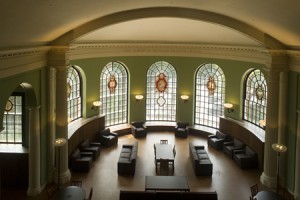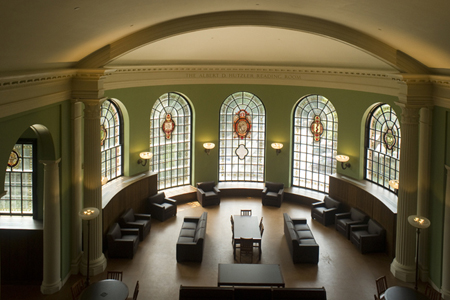Over 90 years after it first opened its doors to students, Gilman Hall at The Johns Hopkins University, received a careful restoration while keeping an eye on the needs of the modern day student. Mr. Travers C. Nelson, AIA, program manager of design and construction for JHU, will lead us on a tour of this impressive building.
Gilman Hall, Johns Hopkins University Campus
3400 N. Charles Street, Baltimore, MD 21218
Thursday, October 13, 5:30 PM – 7:00 PM
$15/members, $20/non-members. Wine & cheese will be served.
Parking is available at the San Martin or South Parking Garages. Street parking is also available on nearby Charles Street.
RSVP today!
 Gilman Hall is 146,000 square feet of classrooms, study space and offices. But it is more than that: it is the intellectual and philosophical heart of the humanities at Johns Hopkins University. Gilman Hall opened in 1915, the first academic building on the Homewood campus, as a single structure with everything a young university student needed for world-class teaching and research. It reopened in 2010 after being closed for two years for renovations, and is now the home at Hopkins for learning in literature, languages, history, philosophy, art, film, and antiquities. “Connections are everything,” said Basil Gildersleeve (1791–1875), the eminent classicist who was the first professor of Greek hired at Johns Hopkins. “Scrap knowledge is the bane of scholars,” he wrote. “Not to see a thing in its connections is not to see it all.” The point of the restoration is to carry out Professor Gildersleeve’s belief.
Gilman Hall is 146,000 square feet of classrooms, study space and offices. But it is more than that: it is the intellectual and philosophical heart of the humanities at Johns Hopkins University. Gilman Hall opened in 1915, the first academic building on the Homewood campus, as a single structure with everything a young university student needed for world-class teaching and research. It reopened in 2010 after being closed for two years for renovations, and is now the home at Hopkins for learning in literature, languages, history, philosophy, art, film, and antiquities. “Connections are everything,” said Basil Gildersleeve (1791–1875), the eminent classicist who was the first professor of Greek hired at Johns Hopkins. “Scrap knowledge is the bane of scholars,” he wrote. “Not to see a thing in its connections is not to see it all.” The point of the restoration is to carry out Professor Gildersleeve’s belief.
The Hall’s design – from its seminar rooms to its atrium – is to encourage faculty members and students to collaborate and explore ideas wherever they lead, even (or especially) across disciplines. The renovation work included everything from the careful restoration of the copper roof of the cupola to the creation, out of an airshaft, of a dramatic atrium covered by a state-of-the-art skylight. Important historic elements have been restored, and essential new spaces and building services have been added. The building is expected to be awarded a LEED Silver certification for sustainability. Please join Mr. Nelson in a tour of the renovated space to learn about the history of the building and its renovation.

